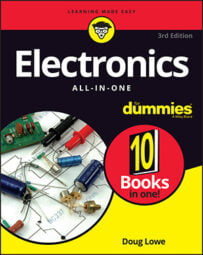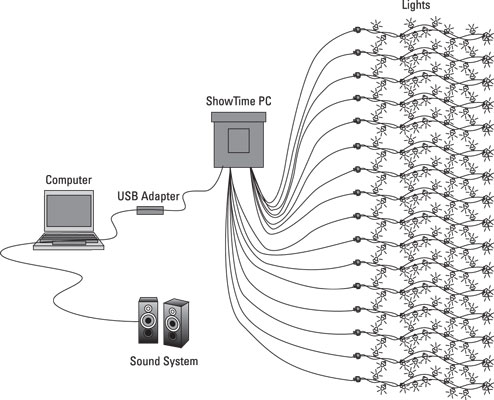The best time to buy lights for your display is the day after Christmas, when most retail stores mark them down at least 50 percent.
The following paragraphs describe the most common types of lights used in holiday displays:
- Incandescent minilights: Strings of 100 or more lights in various colors. These lights are readily available in white, red, green, blue, violet, and yellow. You can also find multicolored strings, which contain a mix of colors. If you hunt around, you may also find other colors. During the Halloween season, you can find orange and purple minilights.
Minilights are designed to run on 2.5 V AC. They're wired in series with 50 lights on each run, which enables them to operate on 120 VAC. The drawback of this arrangement is that because the lights are wired in series, if one of the lights pops out of its socket or comes loose, continuity is broken for the entire run, and all 50 lights will go out.
You can connect strings of minilights end-to-end on a single channel, but you shouldn't connect more than five strings of 100 lights together end-to-end or you'll blow the fuses that are built in to the plugs.
- Net lights: These are minilights woven together into a meshlike net that can be spread over a shrub or other small bush. Usually, each net has 300 lights.
- LED lights: Usually the same size as minilights but made with LEDs rather than incandescent light bulbs. LEDs consume much less power than incandescent lights; in fact, an entire string of LED lights consumes about the same amount of power as a single minilight, and you can connect as many as 20 strings together end-to-end. Thus, you can connect more LEDs to a single channel. However, LED lights are a lot more expensive than incandescent minilights.
- C7 lights: Incandescent lights that are the same size as night lights. Strings of C7 lights are usually made with 25 sockets per string. (The designation C7 refers to the size of the base.)
C7 lights operate on 120 VAC, so they're wired together in parallel. If one goes out or if you remove one, the rest of the string will still light up. You can connect C7 strings end-to-end, but you should connect no more than three strings together to avoid overloading the circuit and blowing out the fuses.
- C9 lights: Similar to C7 lights but bigger.
- Rope lights: Strings of incandescent minilights or LEDs enclosed in a flexible transparent tube. You can purchase short lengths (typically 18 feet) of rope light at retail stores, or you can buy 150-inch commercial-grade spools of rope light online from sources such as 1000Bulbs.com or Christmas Lights Etc.
- Blow-mold figures: Sculptures made of translucent plastic with a light bulb inside. Most blow-mold figures have a single incandescent light bulb inside, typically 40 or 60 W. If you have several blow-mold figures in your display, you can connect them all to a single channel on your controller to turn them on or off together, or, if you have enough channels at your disposal, you can connect each to a separate channel to control each individually. (See why you need more channels?)
- Wire-frame sculptures: Sculptures made from thick wires that are bent and welded into shapes such as deer, Christmas trees, presents, and so on. They are then lit by strings of incandescent minilights or LED lights.
- Megatree: A popular type of light sculpture that is simple to make. All you need is a tall pole and several strings of lights. Attach one end of each string of lights to the top of the pole, and then use stakes to plant the other end of the light strings into the ground, forming a ring around the base of the pole. The more strings of light you use, the better. If you use alternating colors of lights and connect each color to a separate channel, you can create some interesting animation effects.


